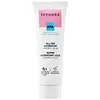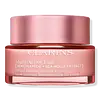Sephora Collection All Day Hyaluronic Acid Hydrator Moisturizer Versus Clarins Multi-Active Day Cream
What's inside
What's inside
 Key Ingredients
Key Ingredients

 Benefits
Benefits

 Concerns
Concerns

 Ingredients Side-by-side
Ingredients Side-by-side

Water
Skin ConditioningCaprylic/Capric Triglyceride
MaskingGlycerin
HumectantButylene Glycol
HumectantHeptyl Undecylenate
EmollientGlyceryl Stearate
EmollientPEG-100 Stearate
Glyceryl Stearate Citrate
EmollientHydroxyethyl Acrylate/Sodium Acryloyldimethyl Taurate Copolymer
Emulsion StabilisingPalmitic Acid
EmollientStearic Acid
CleansingHydroxyacetophenone
AntioxidantMicrocrystalline Cellulose
AbsorbentCaprylyl Glycol
EmollientEthylhexylglycerin
Skin ConditioningTocopherol
AntioxidantHelianthus Annuus Seed Oil
EmollientCaesalpinia Spinosa Gum
Skin ConditioningSodium Hyaluronate
HumectantTocopheryl Acetate
AntioxidantBisabolol
MaskingCellulose Gum
Emulsion StabilisingPolysorbate 60
EmulsifyingSorbitan Isostearate
EmulsifyingSodium Phytate
Arginine
MaskingAscorbyl Glucoside
AntioxidantWater, Caprylic/Capric Triglyceride, Glycerin, Butylene Glycol, Heptyl Undecylenate, Glyceryl Stearate, PEG-100 Stearate, Glyceryl Stearate Citrate, Hydroxyethyl Acrylate/Sodium Acryloyldimethyl Taurate Copolymer, Palmitic Acid, Stearic Acid, Hydroxyacetophenone, Microcrystalline Cellulose, Caprylyl Glycol, Ethylhexylglycerin, Tocopherol, Helianthus Annuus Seed Oil, Caesalpinia Spinosa Gum, Sodium Hyaluronate, Tocopheryl Acetate, Bisabolol, Cellulose Gum, Polysorbate 60, Sorbitan Isostearate, Sodium Phytate, Arginine, Ascorbyl Glucoside
Water
Skin ConditioningCaprylic/Capric Triglyceride
MaskingBetaine
HumectantPropanediol
SolventDicaprylyl Carbonate
EmollientCetearyl Alcohol
EmollientHydrogenated Coco-Glycerides
EmollientNiacinamide
SmoothingPrunus Armeniaca Kernel Oil
MaskingGlycerin
HumectantGlyceryl Stearate
EmollientPEG-100 Stearate
Cetearyl Glucoside
EmulsifyingHydroxyethyl Acrylate/Sodium Acryloyldimethyl Taurate Copolymer
Emulsion StabilisingPropylene Glycol
HumectantDimethicone
EmollientParfum
MaskingSteareth-21
CleansingCaprylyl Glycol
EmollientCellulose
AbsorbentMica
Cosmetic ColorantCI 77891
Cosmetic ColorantEthylhexylglycerin
Skin ConditioningTocopheryl Acetate
AntioxidantDisodium EDTA
Potassium Sorbate
PreservativePolysorbate 60
EmulsifyingSorbitan Isostearate
EmulsifyingButylene Glycol
HumectantCitric Acid
BufferingEryngium Maritimum Extract
TonicMarrubium Vulgare Extract
Skin ConditioningDipsacus Sylvestris Extract
Skin ConditioningPhenethyl Alcohol
MaskingFurcellaria Lumbricalis Extract
Skin ConditioningSodium Citrate
BufferingArbutus Unedo Fruit Extract
AntioxidantTocopherol
AntioxidantLapsana Communis Flower/Leaf/Stem Extract
Skin ConditioningMaris Sal
Skin ConditioningCI 17200
Cosmetic ColorantWater, Caprylic/Capric Triglyceride, Betaine, Propanediol, Dicaprylyl Carbonate, Cetearyl Alcohol, Hydrogenated Coco-Glycerides, Niacinamide, Prunus Armeniaca Kernel Oil, Glycerin, Glyceryl Stearate, PEG-100 Stearate, Cetearyl Glucoside, Hydroxyethyl Acrylate/Sodium Acryloyldimethyl Taurate Copolymer, Propylene Glycol, Dimethicone, Parfum, Steareth-21, Caprylyl Glycol, Cellulose, Mica, CI 77891, Ethylhexylglycerin, Tocopheryl Acetate, Disodium EDTA, Potassium Sorbate, Polysorbate 60, Sorbitan Isostearate, Butylene Glycol, Citric Acid, Eryngium Maritimum Extract, Marrubium Vulgare Extract, Dipsacus Sylvestris Extract, Phenethyl Alcohol, Furcellaria Lumbricalis Extract, Sodium Citrate, Arbutus Unedo Fruit Extract, Tocopherol, Lapsana Communis Flower/Leaf/Stem Extract, Maris Sal, CI 17200
 Reviews
Reviews

Ingredients Explained
These ingredients are found in both products.
Ingredients higher up in an ingredient list are typically present in a larger amount.
Butylene Glycol (or BG) is used within cosmetic products for a few different reasons:
Overall, Butylene Glycol is a safe and well-rounded ingredient that works well with other ingredients.
Though this ingredient works well with most skin types, some people with sensitive skin may experience a reaction such as allergic rashes, closed comedones, or itchiness.
Learn more about Butylene GlycolThis ingredient is an emollient, solvent, and texture enhancer. It is considered a skin-softener by helping the skin prevent moisture loss.
It helps thicken a product's formula and makes it easier to spread by dissolving clumping compounds.
Caprylic Triglyceride is made by combining glycerin with coconut oil, forming a clear liquid.
While there is an assumption Caprylic Triglyceride can clog pores due to it being derived from coconut oil, there is no research supporting this.
Learn more about Caprylic/Capric TriglycerideCaprylyl Glycol is a humectant and emollient, meaning it attracts and preserves moisture.
It is a common ingredient in many products, especially those designed to hydrate skin. The primary benefits are retaining moisture, skin softening, and promoting a healthy skin barrier.
Though Caprylyl Glycol is an alcohol derived from fatty acids, it is not the kind that can dry out skin.
This ingredient is also used as a preservative to extend the life of products. It has slight antimicrobial properties.
Learn more about Caprylyl GlycolEthylhexylglycerin (we can't pronounce this either) is commonly used as a preservative and skin softener. It is derived from glyceryl.
You might see Ethylhexylglycerin often paired with other preservatives such as phenoxyethanol. Ethylhexylglycerin has been found to increase the effectiveness of these other preservatives.
Glycerin is already naturally found in your skin. It helps moisturize and protect your skin.
A study from 2016 found glycerin to be more effective as a humectant than AHAs and hyaluronic acid.
As a humectant, it helps the skin stay hydrated by pulling moisture to your skin. The low molecular weight of glycerin allows it to pull moisture into the deeper layers of your skin.
Hydrated skin improves your skin barrier; Your skin barrier helps protect against irritants and bacteria.
Glycerin has also been found to have antimicrobial and antiviral properties. Due to these properties, glycerin is often used in wound and burn treatments.
In cosmetics, glycerin is usually derived from plants such as soybean or palm. However, it can also be sourced from animals, such as tallow or animal fat.
This ingredient is organic, colorless, odorless, and non-toxic.
Glycerin is the name for this ingredient in American English. British English uses Glycerol/Glycerine.
Learn more about GlycerinGlyceryl Stearate is a mix of glycerin and stearic acid.
It is used to stabilize the mixing of water and oil ingredients. By preventing these ingredients from separating, it can help elongate shelf life. It can also help thicken the product's texture.
As an emollient, it helps soften skin and supports barrier-replenishing ingredients.
In cosmetics, Glyceryl Stearate is often made from vegetable oils or synthetically produced.
This ingredient may not be fungal-acne safe
Fun fact: The human body also creates Glyceryl Stearate naturally.
Learn more about Glyceryl StearateThis is a synthetic polymer. It helps improve the texture of products by adding thickness and gel-like feel.
It is also an emulsifer, meaning it prevents ingredients such as oil and water from separating. It also helps evenly disperse other ingredients.
Peg-100 Stearate is an emollient and emulsifier. As an emollient, it helps keep skin soft by trapping moisture in. On the other hand, emulsifiers help prevent oil and water from separating in a product.
PEGS are a hydrophilic polyether compound . There are 100 ethylene oxide monomers in Peg-100 Stearate. Peg-100 Stearate is polyethylene glycol ester of stearic acid.
Polysorbate 60 is used to help stabilize products. It is a surfactant and emulsifier. These properties help keep ingredients together in a product. Surfactants help reduce surface tension between ingredients with different states, such as liquids and solids. Emulsifiers help prevent oils and waters from separating.
Polysorbate 60 is sorbitol-based and created from the ethoxylation of sorbitan. Ethoxylation is a chemical reaction used to add ethylene oxide. Sorbitan is a the dehydrated version of sorbitol, a sugar found in fruits.
In this case, the 60 comes from reacting 60 units of ethylene oxide with sorbitan.
Polysorbates are commonly used in medicine and foods.
Learn more about Polysorbate 60Sorbitan Isostearate is an emulsifer and cleaning agent. It is created from isostearic acid and sorbitol.
As an emulsifier, Sorbitan Isostearate prevents oils and water from separating.
Due to its isostearic acid base, it may not be safe for Malassezia or fungal acne.
Learn more about Sorbitan IsostearateTocopherol (also known as Vitamin E) is a common antioxidant used to help protect the skin from free-radicals and strengthen the skin barrier. It's also fat soluble - this means our skin is great at absorbing it.
Vitamin E also helps keep your natural skin lipids healthy. Your lipid skin barrier naturally consists of lipids, ceramides, and fatty acids. Vitamin E offers extra protection for your skin’s lipid barrier, keeping your skin healthy and nourished.
Another benefit is a bit of UV protection. Vitamin E helps reduce the damage caused by UVB rays. (It should not replace your sunscreen). Combining it with Vitamin C can decrease sunburned cells and hyperpigmentation after UV exposure.
You might have noticed Vitamin E + C often paired together. This is because it is great at stabilizing Vitamin C. Using the two together helps increase the effectiveness of both ingredients.
There are often claims that Vitamin E can reduce/prevent scarring, but these claims haven't been confirmed by scientific research.
Learn more about TocopherolTocopheryl Acetate is AKA Vitamin E. It is an antioxidant and protects your skin from free radicals. Free radicals damage the skin by breaking down collagen.
One study found using Tocopheryl Acetate with Vitamin C decreased the number of sunburned cells.
Tocopheryl Acetate is commonly found in both skincare and dietary supplements.
Learn more about Tocopheryl AcetateWater. It's the most common cosmetic ingredient of all. You'll usually see it at the top of ingredient lists, meaning that it makes up the largest part of the product.
So why is it so popular? Water most often acts as a solvent - this means that it helps dissolve other ingredients into the formulation.
You'll also recognize water as that liquid we all need to stay alive. If you see this, drink a glass of water. Stay hydrated!
Learn more about Water